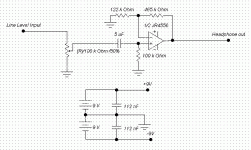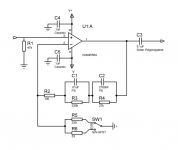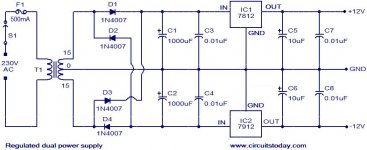this may help
dave
Dave thanks but I think it uses a different op amp but the #s are removed.
Jim
And the schematic Dave posted is the RA-1 headphone amp, a completely different animal.
Oops, i just grabbed the 1st thing that said Grado...
dave
Wow. I'm amazed that the schematic I worked up several years ago is still floating around the web. I should say that the NJM4556A spec is largely a guess, based on the fact that they seemed to be using common parts between the PH and RA-1s. That schematic and my subsequent prototype were based on a series of photographs of the amp, but the markings on most of the parts were either smudged or obscured. The IC used on the PH-1 is most definitely a JRC/NJM part, but I couldn't swear that it is the 4556. I think I tested the prototype with a 4556, but I've always used BB OPA2134PAs in practice as they are widely considered to be a superior part.Njm4556a
Cheers,
-Lee
Just to add to the confusion here is an alternative to consider:
http://www.national.com/ds/LM/LM4562.pdf
The LM4562 is both technically and sonically a great performer - should outperform the JRC part even if used in the Grado circuit.
Note that the data sheet shows a design using passive EQ and a couple of 4562 for stereo.
Interestingly enough it is also available in a metal can because in the Asian high end audio market metal canned op-amps are often preferred. (China in particular..) I have metal canned singles from this family that I have not yet tried.
http://www.national.com/ds/LM/LM4562.pdf
The LM4562 is both technically and sonically a great performer - should outperform the JRC part even if used in the Grado circuit.
Note that the data sheet shows a design using passive EQ and a couple of 4562 for stereo.
Interestingly enough it is also available in a metal can because in the Asian high end audio market metal canned op-amps are often preferred. (China in particular..) I have metal canned singles from this family that I have not yet tried.
Last edited:
Just to add to the confusion here is an alternative to consider:
http://www.national.com/ds/LM/LM4562.pdf
The LM4562 is both technically and sonically a great performer - should outperform the JRC part even if used in the Grado circuit.
Note that the data sheet shows a design using passive EQ and a couple of 4562 for stereo.
Interestingly enough it is also available in a metal can because in the Asian high end audio market metal canned op-amps are often preferred. (China in particular..) I have metal canned singles from this family that I have not yet tried.
So you're saying this is a drop-in replacement for the JRC?
Okay I might build this.
Would the attached PSU work fine?
While not the ultimate it will work fine.
So you're saying this is a drop-in replacement for the JRC?
With some care in layout yes, but I would probably try the application circuit recommended by National..
And now I show the wet behind my ears.
They intend for me to use both channels of the chip per signal, dual mono essentially? I suppose I could split it the other way and use half of each chip per channel but that would theoretically offer less isolation right?
Where they say 22nF//4.7nf//500pF what do they intend, is it a choice depending on desired gain, or do they mean me to run them in parallel or series or something? Same with 3.83kOhm + 100Ohm, is that to mean a 3.83k and then a 100 in series? Why not just illustrate it thusly? I find this circuit more difficult to grasp than the other (poor math skills).
EDIT: I see the other phono pre on page 29... this is easier. But which is better?
They intend for me to use both channels of the chip per signal, dual mono essentially? I suppose I could split it the other way and use half of each chip per channel but that would theoretically offer less isolation right?
Where they say 22nF//4.7nf//500pF what do they intend, is it a choice depending on desired gain, or do they mean me to run them in parallel or series or something? Same with 3.83kOhm + 100Ohm, is that to mean a 3.83k and then a 100 in series? Why not just illustrate it thusly? I find this circuit more difficult to grasp than the other (poor math skills).
EDIT: I see the other phono pre on page 29... this is easier. But which is better?
Last edited:
And now I show the wet behind my ears.
They intend for me to use both channels of the chip per signal, dual mono essentially? I suppose I could split it the other way and use half of each chip per channel but that would theoretically offer less isolation right?
Where they say 22nF//4.7nf//500pF what do they intend, is it a choice depending on desired gain, or do they mean me to run them in parallel or series or something? Same with 3.83kOhm + 100Ohm, is that to mean a 3.83k and then a 100 in series? Why not just illustrate it thusly? I find this circuit more difficult to grasp than the other (poor math skills).
EDIT: I see the other phono pre on page 29... this is easier. But which is better?
I just asked this question!
Yes, caps in parallel to arrive at the correct value.
Yes, resistors in series to arrive at correct value.
I ordered my parts yesterday and will be building a phono pre using two LME49720 dual op amps.
I just asked this question!
Yes, caps in parallel to arrive at the correct value.
Yes, resistors in series to arrive at correct value.
I ordered my parts yesterday and will be building a phono pre using two LME49720 dual op amps.
Is that a common practice? Writing diagrams like that.
I think I'll build this as shown... cheap and cheerful right? Maybe a nice sappele or bubinga case to class it up a bit...
Use a chip per channel, not that cross-talk is a particular problem between the individual op-amps in this device.
Why?
Njm4556a
If that is a bipolar opamp, there is going to be a large dc offset on its output.
Very high dc gain and unbalanced input resistances. In mc mode the opamp may be saturated at one rail. I think that there is a capacitor missing in the feedback
- Status
- This old topic is closed. If you want to reopen this topic, contact a moderator using the "Report Post" button.
- Home
- Source & Line
- Analogue Source
- Grado ph-1 op amp


